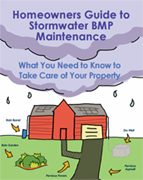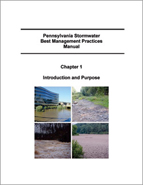|
Storm Water Management HOMEOWNERS
 Modern stormwater management frequently includes
the installation of "Best Management Practices" (BMPS).
Urban stormwater BMPs involve a wide variety of techniques
that reduce storm water pollution from developed areas. One
thing that all BMPs have in common is that they need routine
maintenance to perform properly. Since many BMPs are
installed on private property, it is important that the
owners be offered advice on BMP care. Modern stormwater management frequently includes
the installation of "Best Management Practices" (BMPS).
Urban stormwater BMPs involve a wide variety of techniques
that reduce storm water pollution from developed areas. One
thing that all BMPs have in common is that they need routine
maintenance to perform properly. Since many BMPs are
installed on private property, it is important that the
owners be offered advice on BMP care.
Homeowners Guide to Stormwater BMP Maintenance - click
here This publication was developed under Assistance Agreement No CB-96317101-5 awarded by the U.S. Environmental Protectionm Agency (EPA), and administered by the Pennsylvania Department of Environmental Protection (DEP). The views expressed in this document are solely those of DEP. The mention of any product or commercial service in this publication does not constitute an endorsement by DEP or EPA.
BMP MANUAL
 In undisturbed landscapes, rainwater runoff is part of the
natural hydrologic cycle. Vegetation, soils, and a wide
range of organisms filter, absorb, and use rainfall in their
living processes. Evaporation and transpiration takes place.
Excess precipitation infiltrates into groundwater and flows
into surface waters, recharging aquifers and supporting
aquatic life. The entire system is affected when the
landscape is changed: impervious surfaces (paved streets,
parking lots, rooftops, etc.) prevent runoff from
percolating into the ground and cause it to pick up debris,
sediments, chemicals, and other pollutants as it moves over
the ground. In undisturbed landscapes, rainwater runoff is part of the
natural hydrologic cycle. Vegetation, soils, and a wide
range of organisms filter, absorb, and use rainfall in their
living processes. Evaporation and transpiration takes place.
Excess precipitation infiltrates into groundwater and flows
into surface waters, recharging aquifers and supporting
aquatic life. The entire system is affected when the
landscape is changed: impervious surfaces (paved streets,
parking lots, rooftops, etc.) prevent runoff from
percolating into the ground and cause it to pick up debris,
sediments, chemicals, and other pollutants as it moves over
the ground.
In order to assist municipalities, designers,
developers, and engineers in understanding, developing, and
implementing stormwater management programs, PA DEP
published the PA Stormwater BMP Manual in 2006.
As noted in the
Foreword:
"The Manual is intended to be a
tool to achieve the regulatory standard to protect, maintain, and improve
the Commonwealth's water resources through comprehensive site planning and
BMP design guidance, while allowing for the continued growth and development
of Pennsylvania."
As such, the Manual's main focus is on BMPs that help meet the requirements of
MCMs 4 through 6. These BMPs are generally classified as "non-structural"
(design and planning techniques that preserve natural systems and hydrologic
functions on a site) and "structural" (more conventional 'brick and mortar'
techniques, which may include vegetation and soil-based mechanisms.) The key
distinction between Non-Structural and Structural BMPs is that the former are
intended to prevent stormwater generation, while the focus of the latter is on
mitigating unavoidable stormwater-related impacts.
When it comes to development, the Stormwater Management Program described in the
Manual emphasizes a comprehensive total site design approach. Whether referred
to as "Low Impact Development", "Conservation Design", or "Green Design", this
environmentally sensitive approach to site development and stormwater management
aims to minimize the effect of development on water, land, and air resources.
The use of best management practices, or BMPs, is the primary method of
controlling stormwater discharges and preventing runoff from adversely affecting
water quality. BMPs are a suite of planning processes, development
methodologies, and specific techniques designed to be used in combination to:
- Prevent disturbances to natural systems and hydrologic functions; and
- Minimize the impacts of disturbances where they do occur.
This guidance Manual identifies information on resource planning, techniques for
land development, and concepts and procedures for designing and implementing
performance-based BMPs for managing stormwater for quantity and quality. The
comprehensive planning approach to stormwater management emphasizes reducing the
impacts of development activities through the mitigation process by employing
practices that avoid and minimize potential impacts to watershed resources. The
BMPs are designed to minimize or mitigate for the unavoidable impacts that
development has on watershed resources.
This manual lists various BMPs and design standards, which are acceptable in
Pennsylvania to manage stormwater and prevent pollution of waters of the
Commonwealth. Stormwater management plans and the BMPs designed according to
these standards when properly applied, implemented and maintained, will achieve
the Department's water quality mandates established in 25 Pa. Code Chapter 93
and required by the federal Clean Water Act, federal NPDES regulations, the
Pennsylvania Storm Water Management Act and the Pennsylvania Clean Streams Law.
The proper utilization and implementation of these BMPs will protect and
maintain existing uses and the level of water quality necessary to protect the
existing uses, and will protect and maintain the water quality of high quality
and exceptional value waters of the Commonwealth. |